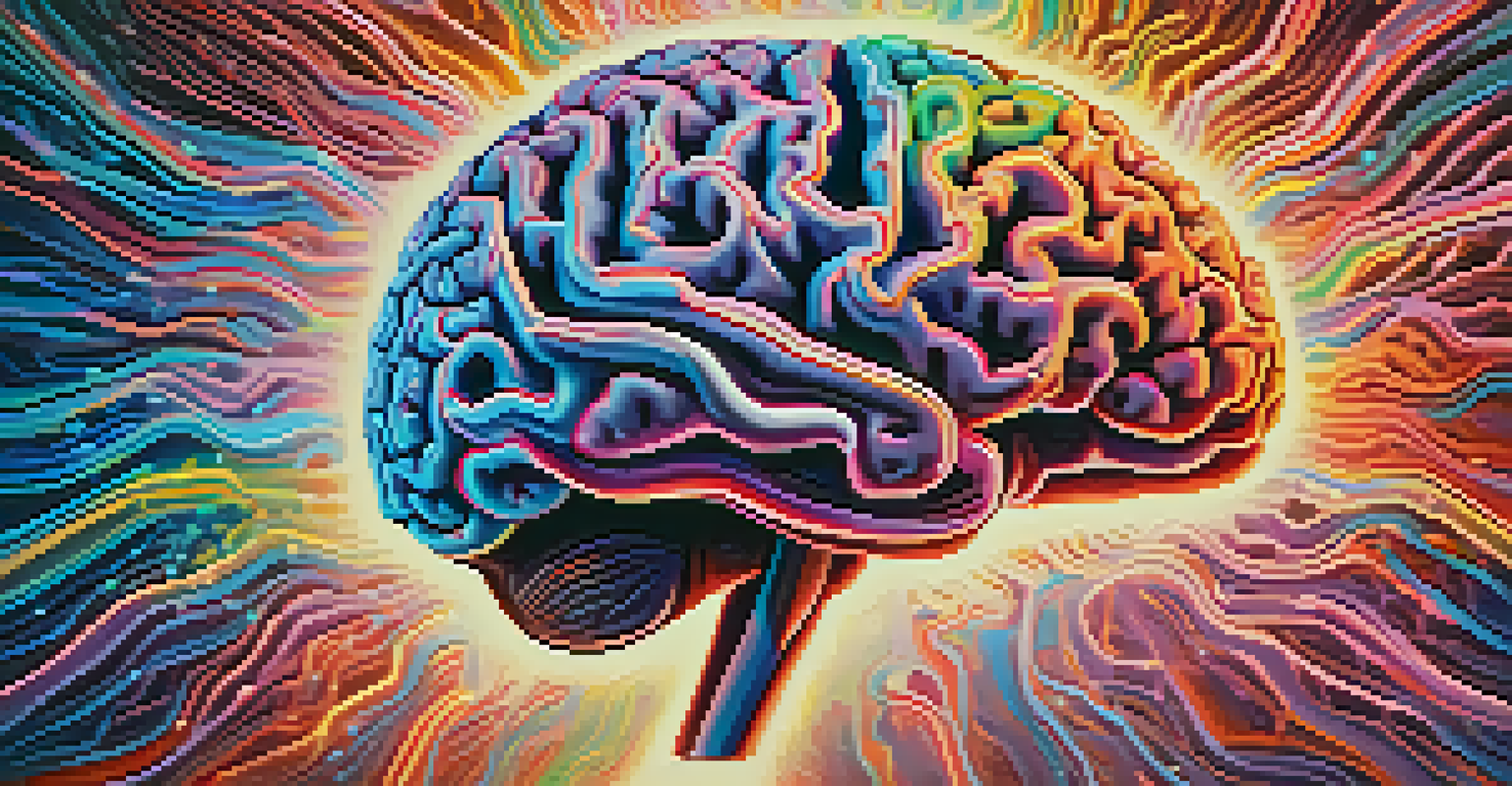Investigating Brain Activity: Hallucinogens and the DMN

Understanding the Default Mode Network (DMN)
The Default Mode Network (DMN) is a fascinating brain network involved in self-referential thoughts and daydreaming. It’s often active when we’re at rest, reflecting on past experiences or planning for the future. Picture the DMN as your mind's default setting, where introspection and imagination flourish. When we engage in deep thought or creativity, the DMN lights up, showcasing its role in our cognitive processes.
The mind is everything. What you think you become.
Interestingly, the DMN has been linked to various mental health conditions, including depression and anxiety. When this network is overactive, it can contribute to rumination and excessive self-focus, leading to negative thought patterns. Understanding the DMN is crucial for researchers as they explore its connection to consciousness and mental well-being, especially in relation to external influences like hallucinogens.
To better grasp the DMN's significance, consider how it operates during our waking hours. Imagine it as the background music to our thoughts—often unnoticed but ever-present. This network's dynamics are essential for understanding how our thoughts and emotions intertwine, paving the way for further investigation into how substances like hallucinogens might alter our mental landscape.
The Role of Hallucinogens in Brain Activity
Hallucinogens, such as psilocybin and LSD, dramatically alter brain activity, leading to profound changes in perception and consciousness. These substances can disrupt the normal functioning of the DMN, often decreasing its activity and allowing for enhanced connectivity across other brain regions. Imagine taking off a pair of heavy glasses that have been distorting your view; suddenly, everything becomes clearer and more vibrant.

Research has shown that when individuals consume hallucinogens, their experiences can include heightened emotional awareness and a sense of interconnectedness with the world. This is particularly interesting, as it suggests that hallucinogens may offer therapeutic benefits for conditions like PTSD and depression. By temporarily quieting the DMN, these substances can create a unique space for psychological healing and insight.
DMN's Role in Mental Health
The Default Mode Network (DMN) is crucial for understanding self-referential thoughts and its overactivity can contribute to mental health issues like depression and anxiety.
Moreover, the effects of hallucinogens extend beyond mere visual or auditory hallucinations. They can lead to a complete reorganization of thought processes, allowing individuals to perceive their thoughts and emotions from different perspectives. This shift can be likened to stepping outside of a crowded room to gain a fresh view on a heated discussion—suddenly, things that seemed overwhelming become manageable.
How Hallucinogens Impact the DMN
Research indicates that hallucinogens can dampen the activity of the DMN, which is often associated with a decrease in ego and self-referential thinking. This can lead to experiences of 'ego dissolution,' where individuals feel a sense of unity with their surroundings, transcending their individual identity. Think of it as peeling away layers of an onion; with each layer removed, you get closer to the core of existence.
The greatest discovery of my generation is that a human being can alter his life by altering his attitudes.
The altered state of consciousness produced by hallucinogens allows for a unique exploration of the self, free from the constraints of everyday thoughts and worries. Studies using brain imaging technologies have documented these changes, revealing a decrease in DMN activity coupled with increased connectivity between other brain regions. It's as if the brain is rewriting its internal map, creating new pathways for understanding and perception.
This dynamic interplay between hallucinogens and the DMN has significant implications for mental health treatment. By understanding how these substances influence brain activity, researchers can develop targeted therapies that harness the power of altered consciousness to promote healing and personal growth. The journey into the brain's workings is just beginning, and the DMN plays a pivotal role in this exploration.
Therapeutic Potential of Hallucinogens
The therapeutic potential of hallucinogens is gaining traction in the scientific community, particularly for mental health conditions resistant to traditional treatments. By investigating how these substances impact the DMN, researchers are uncovering new possibilities for healing. Imagine a toolbox filled with various tools—each one designed to tackle specific issues; hallucinogens could become valuable tools in mental health therapy.
Clinical trials have demonstrated promising results, showing that substances like psilocybin can lead to significant reductions in depression and anxiety. Participants often report life-changing experiences that allow them to confront emotions and memories in a new light. This process of reframing can be likened to cleaning a dusty old window; once the grime is removed, the view becomes clear and bright.
Hallucinogens and the DMN
Hallucinogens can dampen DMN activity, leading to experiences of ego dissolution and offering potential therapeutic benefits for mental health conditions.
However, it’s essential to approach this field with caution and respect. While the results are encouraging, further research is needed to understand the long-term implications and best practices for using hallucinogens in therapy. As we navigate this evolving landscape, the ultimate goal is to harness the benefits of hallucinogens while ensuring safety and efficacy for those in need.
Challenges in Hallucinogen Research
Despite the promising findings on hallucinogens and the DMN, research in this area faces several challenges. One significant hurdle is the stigma surrounding these substances, which can hinder funding and institutional support for studies. Overcoming this stigma is crucial to unlocking the full potential of hallucinogen research and its therapeutic applications.
Another challenge is the regulatory environment. Many hallucinogens remain classified as illegal substances, making it difficult for researchers to conduct studies. This can lead to a lack of rigorous scientific data, which is necessary for establishing the safety and efficacy of these treatments. Imagine trying to study a rare bird species in a restricted area; researchers face similar obstacles when examining the effects of hallucinogens.
Moreover, individual variability in responses to hallucinogens complicates research efforts. Factors such as genetics, mental health history, and environmental influences can affect how someone experiences these substances. It's essential for researchers to consider these variables to ensure that findings are applicable to diverse populations and can inform future therapeutic practices.
Future Directions in Hallucinogen Research
As interest in hallucinogens grows, the future of research in this area looks promising. Scientists are increasingly focused on understanding the specific mechanisms by which these substances interact with the DMN and other brain networks. This knowledge could pave the way for new treatment options and a deeper understanding of consciousness itself.
Innovative approaches, such as combining hallucinogens with psychotherapy, are being explored as potential methods for enhancing therapeutic outcomes. This integrated model could provide individuals with the support needed to navigate their experiences safely and meaningfully. Think of it as a skilled guide leading you through a dense forest; having someone knowledgeable can make all the difference in finding your way.
Challenges in Hallucinogen Research
Stigma, regulatory issues, and individual variability present significant challenges for research on hallucinogens and their therapeutic applications.
Additionally, researchers are beginning to examine the long-term effects of hallucinogen-assisted therapy, assessing how these treatments impact mental health over time. By gathering comprehensive data, the scientific community can build a solid foundation for the responsible use of hallucinogens in clinical settings. The journey into the mind's depths is just beginning, and each step forward holds the promise of discovery.
Conclusion: The Intersection of Hallucinogens and the DMN
The exploration of hallucinogens and their effects on the Default Mode Network provides fascinating insights into the workings of the human mind. As we peel back the layers of understanding, we find a complex interplay between brain activity, consciousness, and therapeutic potential. The DMN serves as a key player in this narrative, highlighting the importance of introspection and self-awareness in our mental health journey.
While challenges remain, the growing body of research points toward a future where hallucinogens could play a vital role in mental health treatment. By embracing the potential of these substances, we open the door to innovative therapies that promote healing and personal growth. It's a thrilling time in the field of psychology, as we stand on the brink of new discoveries that could transform lives.

In conclusion, the intersection of hallucinogens and the DMN offers a unique lens through which we can examine consciousness and mental health. As we move forward, it's essential to approach this topic with curiosity and respect, ensuring that we prioritize safety and efficacy in our quest for understanding. The journey into the mind is an ongoing adventure, filled with possibilities waiting to be unveiled.